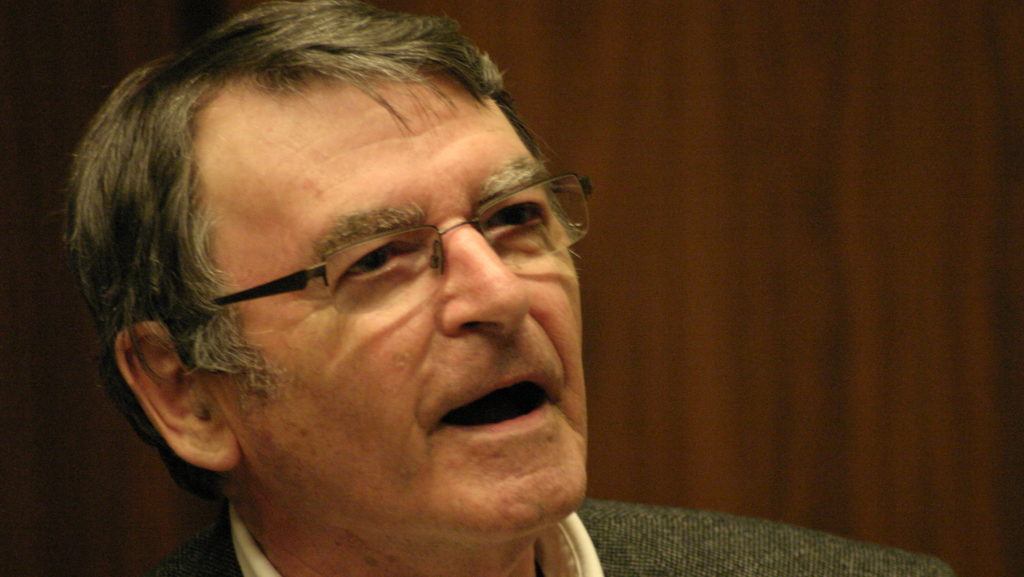Waugh, Greene, Mauriac, Tolkien, O’Connor. You know them — the heart of the 20th century Catholic literary canon. Less familiar, especially to American readers, but deserving of his own spot, is the British writer David Lodge, who died on New Year’s Day at the age of 89.
David Lodge wrote novels, essays, plays and teleplays. He also enjoyed a long academic career. His novels are comic, satiric, and ever a bit elegiac, all with subtexts of the loss that comes of making a choice, even a desired choice, the comic-tragic folly of human beings who exist in the paradox of unbounded spirits and limited bodies.
His fiction may not be purely autobiographical, but each work emerges from a particular point in Lodge’s life: from his childhood during the Second World War (“Out of the Shelter”) to his required years of national service (“Ginger’s Gone Barmy”), academic life in the brilliant “Campus Trilogy,” to his later works which provide a glimpse into the challenges of middle-age, including aging parents and the onset of his own deafness (“Deaf Sentence”).
And, yes, Catholicism: Lodge was a cradle Catholic whose personal faith shifted over the decades. His first novel, “The Picturegoers” (1960) featured a protagonist with a nominal Catholic background much like Lodge’s own, who takes a room with a large Irish Catholic family. The character is deeply attracted to both one of the family’s daughters as well as their messy, animated faith.
But in an introduction to a 1993 edition of the book, he commented: “Looking back at that aspect of ‘The Picturegoers’ from my present demythologized, provisional and in many ways agnostic theological perspective, it seems like the work of another person.”
Lodge’s two most explicitly “Catholic” novels point us to the shape of this journey, reflecting the experiences of young British Catholics of his own generation in the years before, during and after the Second Vatican Council.
“The British Museum is Falling Down,” published in 1965, is a short, hilarious novel that follows a young British graduate student, Adam Appleby, through a single day of his frenetic life: trying to do research (in the British Museum reading room, of course) meeting academic obligations and, crucially, dealing with the pressures of family life. Those pressures are especially acute because the near-impoverished Applebys, faithful Catholics with their three children, seem to be hovering on the edge of something because Barbara Appleby’s period is late.
Adam’s misadventures and interior monologues, written in a pastiche of varied literary styles in tribute to authors such as Graham Greene, Kafka and James Joyce, bring us into the experience of young adult Catholics of the period trying to sort through the knotty problems brought by the intersection of Church teaching, real life, and ambiguous signals from Rome at the end of the Second Vatican Council.
“Souls and Bodies” (or, in its much more wryly descriptive British title “How Far Can You Go?”) did this with a larger cast of characters over years, not hours. The novel opens in a college chapel in the 1950’s, where a group of Catholic college students have gathered for daily Mass. We follow them through their marriages, childbirths, vocational discernments, sexual adventures and spiritual searches, ending, brilliantly, with the group gathered for worship again, but this time in the early 70’s, in an open field for an Easter celebration featuring a liberation theologian imported from South America as the star.
What a difference fifteen years made. And in retrospect, how poignant is the question in the British title. The young adult Catholics had been obsessed with the question of how “far can you go” in intimacy before you commit a certain type of sin, but the greater question becomes “ … in matters of belief...how far can you go in this process without throwing out something vital?”
I am somewhat of an evangelist for Lodge’s work, especially those last two titles, among Catholics. Lodge’s characters are a generation older than I am, but the experiences he describes with such clarity and bite are recognizable even to me as important background for contemporary discussions.
The fact is, we are still living in the middle of this history, and many of the arguments about where we should be as a Church today are rooted in our understanding of what the Church used to be like. Much of what we hear in our debates does not come from folks who actually lived it, but who project their expectations and ideologies on a fantasy of the past. This goes for those who ponder questions like, “How could people have abandoned that beauty and clarity?”as well as those who assert,“What a blessing all that pointless nonsense was tossed out!”
Lodge’s two novels offer more than a helpful historical record. They offer a way of seeing the human beings who lived it, a way of seeing that is paradoxically sharp, yet at its heart, quite generous.
Lodge, as his own words make clear, ended up with more “progressive” notions of Catholicism. But because he is ultimately sympathetic to all of his characters and honestly explores their behavior and motivations, the reader never loses sight of the yearning at the heart of every person’s spiritual journey.
David Lodge treated the oddballs and searching denizens of his fictional Catholic worlds with humor, honesty and an attempt, at least, at understanding. Perhaps his work can encourage us, in our very real Catholic world, to do the same.

